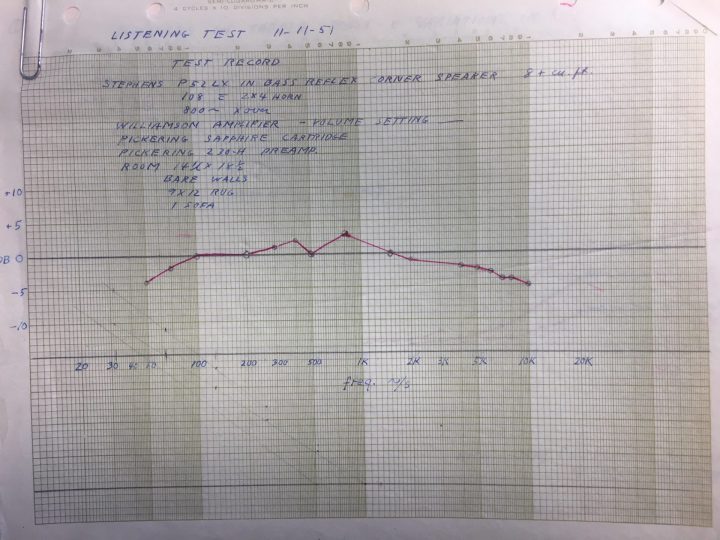In Copper #52 we began poring through a collection of audio ephemera gathered by Dr. James McVay, the grandfather of fellow columnist Duncan Taylor. Dunc brought in a binder full of material from the ’50s through the ’70s, and further complicated the sorting-out of things by bringing in a second binder. Of. More. Stuff.
Dr. McVay was seriously afflicted with audiophilia; like many audiophiles with scientific training, he set out to verify for himself the performance of a number of component elements of his system. He tested a variety of different amps and speakers, hand-plotting frequency response on semi-log graph paper, charting the differences made by crossover changes, different component values in the Williamson amp he built, and so on. There are a number of handwritten notes with detailed calculations for all the permutations; fascinating stuff until the fountain pen scratches become indecipherable—he was a doctor, after all.
We often describe a dedicated amateur as a “serious hobbyist”, which seems a bit oxymoronic, along the lines of “jumbo shrimp”. Origins of the word “hobby” are unclear, but there’s no denying its association with a hobby horse, the rocking horse-replica ridden by small children. How the leap was made from that to “a dedicated pastime” is unclear, although one etymological source theorizes that the link is that both are “an activity that doesn’t go anywhere”. That seems to me to be cruel enough to be factual.
At any rate, Dr. McVay was indeed a dedicated amateur, a serious hobbyist. While he went through many different pieces of gear through the years, he held on to a Williamson amp that he built in the early ’50s, and which Duncan still has today. The who, how, and why of the Williamson amp will likely be the subject of a future Vintage Whine or two, but in brief, the Williamson was a mono amp detailed by engineer DTN Williamson, described in a series of articles that ran in Wireless World in 1947, with revisions and addenda published in 1949. For many years the amp was a favorite of hobbyists due to its relative simplicity of construction and very low distortion.
 These days, the Williamson's high levels of feedback has caused it to lose favor among valve aficianados---but for many years, it was king. It was so popular that Wireless World reprinted Williamson's articles in a booklet...this booklet:
These days, the Williamson's high levels of feedback has caused it to lose favor among valve aficianados---but for many years, it was king. It was so popular that Wireless World reprinted Williamson's articles in a booklet...this booklet: 
As you can tell from the booklet’s condition, the price of three shillings, sixpence, and Dr. McVay’s signature—this has been around a while. The pages are rounded and dog-eared, some schematics have notations written upon them. It was clearly used and repeatedly referred to. Back in the ’90s, Audio Amateur magazine reprinted the booklet; while presently out of print, copies of both the original and the reprint can be found on Amazon and eBay.
At the heart of the Williamson amp were transformers designed and built by the UK firm Partridge Transformers Ltd. There was a brochure and letter from Partridges:

Gotta love that logo.
The Williamson amp was part of the system measured in 1951 (also seen in the header pic):
 Similar graphs plotted the results of 1952 crossover experiments:
Similar graphs plotted the results of 1952 crossover experiments:  Even twenty years later, the Williamson amp was still in the picture, as component elements were checked to see if they were still in spec:
Even twenty years later, the Williamson amp was still in the picture, as component elements were checked to see if they were still in spec:  Systems come, systems go, and audiophiles rarely chart the changes. It was fascinating to me to see the documented efforts of a dedicated and painstaking audio amateur over the course of several decades. Thanks to Duncan Taylor for sharing this material with all of us.
Systems come, systems go, and audiophiles rarely chart the changes. It was fascinating to me to see the documented efforts of a dedicated and painstaking audio amateur over the course of several decades. Thanks to Duncan Taylor for sharing this material with all of us.



